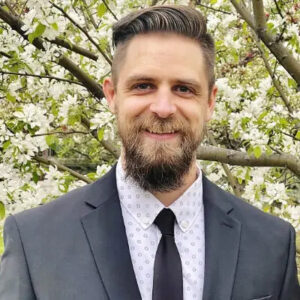
Dr. Holland with his practice administrator, Erika Weivoda. Dr. Holland says the practice went through an organized process to determine how to maximize vision plan reimbursements.
Correcting mistakes when billing for medically necessary contact lenses.
By Zachary Holland, OD, FSLS
Feb. 7, 2024
In my practice, 45 percent of contact lens evaluations performed each month are specialty lens fits for keratoconus or ectasia. While contracted reimbursement rates vary, vision plan reimbursement for medically necessary lenses is usually topnotch.
So, what happens when a problem occurs on the billing side of evaluations? Who notices it? How do you recoup the losses?
Developing a Plan to Recoup Losses
My practice administrator and I were looking at our vision plan payments, and only saw a few full payments made based off the contract rate for our medically necessary contact lenses, even though we had submitted many more. Many paid amounts were totals much lower than we were accustomed to receiving.
When we researched the issue, we found that we had been receiving low-paying reimbursements for months. At this point, we knew we had to try to recoup our losses.
This issue started before our current biller worked at our clinic. The previous biller did not correctly bill medically necessary claims, and this trend was overlooked and continued with our new biller.
Our first step was to go through our reports, noting every patient who had been fit with specialty, medically necessary contact lenses. Our second step was to cross-reference those patients with the amounts paid. Any low-paying claims warranted further research.
This particular vision plan allows claims to be reprocessed up to 12 months past the claim submission date. To bill a medically necessary claim, it is imperative to review the provider manual to be sure all requirements are met. Each vision plan has specific criteria that need to be met in order to qualify as “medically necessary,” and some vision plans direct the reimbursement based on the severity of the condition. I cannot stress enough the importance that all of your providers are familiar with these conditions or have a printed-0ut card with the criteria. A simple error has the potential to cost your practice over $1,000 for a single patient.
In my clinic, we use codes 92072 and 92313, with our most frequent Dx codes H18.6xx, H18.7xx and Z94.7 with a v code of v2531.
Identifying the Culprit Behind Low-Paying Claims
I am embarrassed to say that we were making the simplest of errors. The most important box when billing medically necessary is box 19.
Box 19 is where to input the manufacturer, brand and type of lens. Without this filled out, reimbursement will revert any v2531 lens reimbursement amount to the v2599 reimbursement amount, which is a difference of $1,000 per claim. If a soft contact lens is billed in conjunction with a scleral lens, without box 19 completed, this vision plan will reimburse at the lowest contact lens reimbursement amount, which can mean a loss of up to $1,500 per patient! I was aware of this, but during the training period for my new employee, this was overlooked.
Other Articles to Explore
Checking Low-Paying Claims
To begin the process of checking low-paying claims, my practice administrator went to the “administration/explaining of payment” section of the vision plan’s website. It is easy to check each patient for the claim number to check what codes were billed, the co-pays and the final reimbursement amount. Once we ascertained which patient claims were affected, we were able to complete a contact lens claim correction online.
This process took my practice administrator about one month to find our eligible low-paying claims and to resubmit a corrected claim.
Vision plans retract the original payment amount and pay the new adjusted amount in full. Again, this is all available to look at online. In the end, my practice was able to recoup an additional $47,000 in lost revenue over a 12 month period.
Special credit to my practice administrator, Erika Weivoda, for both contributing to this article and recouping these funds for my office!
 Zachary Holland, OD, FSLS, is the owner of Cornea & Contact Lens Institute of Minnesota. To contact him: drholland@corneaandcontactlensinstitute.com
Zachary Holland, OD, FSLS, is the owner of Cornea & Contact Lens Institute of Minnesota. To contact him: drholland@corneaandcontactlensinstitute.com

























